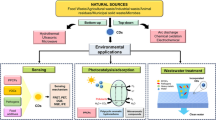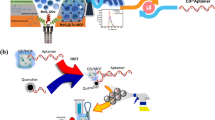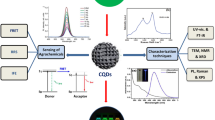Abstract
Humic acid–based carbon dots (HACDs) have excellent properties and are widely used in environmental detection, bioimaging, and optoelectronic materials. Herein, we investigated the structure–activity relationship between the morphology and optical properties of HACDs, and reported on a novel strategy for metronidazole (MNZ) and ornidazole (ONZ) sensing in multiple real samples. It was found that the average particle size decreased from 3.28 to 2.44 nm, optimal emission wavelength was blue-shifted from 500 to 440 nm, and the quantum yield (QY) improved from 5 to 23% with the temperature increasing from 110 to 400 °C. Under the oxidation of hydrogen peroxide (H2O2) and potassium permanganate (KMnO4), the UV–vis spectra of HACD aqueous solution showed time-dependent behavior, and the fluorescence emission of HACDs achieved spectrally tunable multi-color luminescence in the temporal dimension. The surface of HACDs contained a large number of hydroxyl (–OH) and carboxyl (–COOH) fluorophores, resulting in excellent pH sensing. Meanwhile, the synthesized HACDs revealed sensitive response to MNZ and ONZ with the limit of detection (LOD) of 60 nM and 50 nM in aqueous solutions, which had also been successfully applied in various actual samples such as lake water, honey, eggs, and milk with satisfactory results because of the inner filter effect (IFE). Our research is advantageous to enhance the potential applications of HACDs in advanced analytical systems.
Graphical abstract







Similar content being viewed by others
References
Xu XY, Ray R, Gu YL, Ploehn HJ, Gearheart L, Raker K, Scrivens WA. Electrophoretic analysis and purification of fluorescent single-walled carbon nanotube fragments. J Am Chem Soc. 2004;126(40):12736–7. https://doi.org/10.1021/ja040082h.
Ding H, Yu SB, Wei JS, Xiong HM. Full-color light-emitting carbon dots with a surface-state-controlled luminescence mechanism. ACS Nano. 2016;10(1):484–91. https://doi.org/10.1021/acsnano.5b05406.
Li XC, Zhao SJ, Li BL, Yang K, Lan MH, Zeng LT. Advances and perspectives in carbon dot-based fluorescent probes: mechanism, and application. Coord Chem Rev. 2021;431:213686. https://doi.org/10.1016/j.ccr.2020.213686.
Bai JL, Ma YS, Yuan GJ, Chen X, Mei J, Zhang L, Ren LL. Solvent-controlled and solvent-dependent strategies for the synthesis of multicolor carbon dots for pH sensing and cell imaging. J Mater Chem C. 2019;7(31):9709–18. https://doi.org/10.1039/c9tc02422k.
Basu N, Mandal D. Time-resolved photoluminescence of pH-sensitive carbon dots. Carbon. 2019;144:500–8. https://doi.org/10.1016/j.carbon.2018.12.056.
Yang SL, Wang L, Zuo L, Zhao C, Li HY, Ding L. Non-conjugated polymer carbon dots for fluorometric determination of metronidazole. Microchim Acta. 2019;186:652. https://doi.org/10.1007/s00604-019-3746-5.
Wu WZ, Wu XY, He M, Yuan XL, Lai JP, Sun H. A novel carbon dot/polyacrylamide composite hydrogel film for reversible detection of the antibacterial drug ornidazole. RSC Adv. 2021;11(37):22993–3001. https://doi.org/10.1039/d1ra01478a.
Koventhan C, Vinothkumar V, Chen SM. Development of an electrochemical sensor based on a cobalt oxide/tin oxide composite for determination of antibiotic drug ornidazole. New J Chem. 2021;45(28):12593–605. https://doi.org/10.1039/d1nj01345a.
Fan YJ, Su M, Shi YE, Liu XT, Shen SG, Dong JX. A ratiometric fluorescent sensor for tetracyclines detection in meat based on pH-dependence of targets with lanthanum-doped carbon dots as probes. Anal Bioanal Chem. 2022;414:2597–606. https://doi.org/10.1007/s00216-022-03895-x.
Mehrzad SM, Faridbod F, Dezfuli AS, Ganjali MR. A novel metronidazole fluorescent nanosensor based on graphene quantum dots embedded silica molecularly imprinted polymer. Biosens Bioelectron. 2017;92:618–23. https://doi.org/10.1016/j.bios.2016.10.047.
Ren GD, Hou XY, Kang Y, Zhang R, Zhang M, Liu W, Li LH, Wei SY, Wang HJ, Wang B, Diao HP. Efficient preparation of nitrogen-doped fluorescent carbon dots for highly sensitive detection of metronidazole and live cell imaging. Spectrochim Acta A Mol Biomol Spectrosc. 2020;234:118251. https://doi.org/10.1016/j.saa.2020.118251.
Du JY, Wang CF, Yuan PC, Shu Q, Xu N, Yang Y, Qi SQ, Ye Y, Zhu CQ. One-step hydrothermal synthesis of nitrogen-doped carbon dots as a super selective and sensitive probe for sensing metronidazole in multiple samples. Anal Methods. 2021;13(39):4652–61. https://doi.org/10.1039/d1ay01009c.
Liu HC, Ding J, Zhang K, Ding L. Fabrication of carbon dots@restricted access molecularly imprinted polymers for selective detection of metronidazole in serum. Talanta. 2020;209:120508. https://doi.org/10.1016/j.talanta.2019.120508.
Yang XP, Liu MX, Yin YR, Tang FL, Xu H, Liao XJ. Green, hydrothermal synthesis of fluorescent carbon nanodots from gardenia, enabling the detection of metronidazole in pharmaceuticals and rabbit plasma. Sensors. 2018;18(4):964. https://doi.org/10.3390/s18040964.
He ZG, Liu SJ, Zhang C, Fan LY, Zhang J, Chen Q, Sun YD, He LF, Wang ZC, Zhang K. Coal based carbon dots: recent advances in synthesis, properties, and applications. 2021; 2(9):1589–604. https://doi.org/10.1002/nano.202100019.
Shi WJ, Fan H, Ai SY, Zhu LS. Preparation of fluorescent graphene quantum dots from humic acid for bioimaging application. New J Chem. 2015;39(9):7054–9. https://doi.org/10.1039/c5nj00760g.
Saikia M, Das T, Dihingia N, Fan X, Silva LFO, Saikia BK. Formation of carbon quantum dots and graphene nanosheets from different abundant carbonaceous materials. Diamond Relat Mater. 2020;106:107813. https://doi.org/10.1016/j.diamond.2020.107813.
Liu X, Han J, Hou XD, Altincicek F, Oncel N, Pierce D, Wu X, Zhao JXJ. One-pot synthesis of graphene quantum dots using humic acid and its application for copper(II) ion detection. J Mater Sci. 2021;56:4991–5005. https://doi.org/10.1007/s10853-020-05583-6.
He ZG, Zhang C, Zhang J, Liu SJ, Sun YD, Chen Q, Chu ZL, Ye MF, Zhang K. Concentration-dependent multi-color humic acid-based carbon dots for luminescent polymer composite films. J Mater Sci. 2022;57:1069–83. https://doi.org/10.1007/s10853-021-06606-6.
Liu ML, Li TT, Zhang C, Zheng Y, Wu CQ, Zhang J, Zhang K, Zhang ZP. Fluorescent carbon dots embedded in mesoporous silica nanospheres: a simple platform for Cr(VI) detection in environmental water. J Hazard Mater. 2021;415:125699. https://doi.org/10.1016/j.jhazmat.2021.125699.
Tian Z, Zhang XT, Li D, Zhou D, Jing PT, Shen DZ, Qu SN, Zboril R, Rogach AL. Full-color inorganic carbon dot phosphors for white-light-emitting diodes. Adv Optical Mater. 2017;5(19):1700416. https://doi.org/10.1002/adom.201700416.
Ding H, Wei JS, Zhang P, Zhou ZY, Gao QY, Xiong HM. Solvent-controlled synthesis of highly luminescent carbon dots with a wide color gamut and narrowed emission peak widths. Small. 2018;14(22):1800612. https://doi.org/10.1002/smll.201800612.
Xiong YK, Jin LJ, Yang H, Li Y, Hu HQ. Insight into the aromatic ring structures of a low-rank coal by step-wise oxidation degradation. Fuel Process Technol. 2020;210:106563. https://doi.org/10.1016/j.fuproc.2020.106563.
Nguyen V, Si JH, Yan LH, Hou X. Electron-hole recombination dynamics in carbon nanodots. Carbon. 2015;95:659–63. https://doi.org/10.1016/j.carbon.2015.08.066.
Wu P, Xiong Y, Lei C, Li Y, Liu X, Zhang C, Sun YD, Zhang J, Lee CS, Zhang K. Chemical analysis and identification the fluorophores of photoluminescent carbon dots beyond infrared and X-ray photoelectron energy spectra. Dyes Pigm. 2021;195:109750. https://doi.org/10.1016/j.dyepig.2021.109750.
Yan FY, Jiang YX, Sun XD, Wei JF, Chen L, Zhang YY. Multicolor carbon dots with concentration-tunable fluorescence and solvent-affected aggregation states for white light-emitting diodes. Nano Res. 2020;13(1):52–60. https://doi.org/10.1007/s12274-019-2569-3.
Liu XX, Yang CL, Zheng BZ, Dai JY, Yan L, Zhuang ZJ, Du J, Guo Y, Xiao D. Green anhydrous synthesis of hydrophilic carbon dots on large-scale and their application for broad fluorescent pH sensing. Sens Actuators B Chem. 2018;255:572–9. https://doi.org/10.1016/j.snb.2017.08.101.
Zhang JY, Lu XM, Lei Y, Hou XD, Wu P. Exploring the tunable excitation of QDs to maximize the overlap with the absorber for inner filter effect-based phosphorescence sensing of alkaline phosphatase. Nanoscale. 2017;9(40):15606–11. https://doi.org/10.1039/c7nr03673f.
Funding
This work was supported by the National Natural Science Foundation of China (No. 62175262, 21976002, 62104003, and 22004003), School Level Natural Science Research Project (2021tlxy16), Natural Science Foundation of Anhui Province (2008085J11, 1908085QB75), and Natural Science Foundation of Anhui Universities (KJ2020A0228).
Author information
Authors and Affiliations
Contributions
Ziguo He: investigation; methodology; writing—original draft. Jiaxu Liu and Cheng Zhang: methodology, editing. Yudie Sun: investigation. Qian Chen and Shengjun Liu: validation, conceptualization, formal analysis. Jian Zhang and Mingfu Ye: formal analysis, investigation. Caibo Yue: writing review and editing. Kui Zhang: writing review and editing, supervision.
Corresponding authors
Ethics declarations
Competing interests
The authors declare no competing interests.
Additional information
Publisher's note
Springer Nature remains neutral with regard to jurisdictional claims in published maps and institutional affiliations.
Published in the topical collection Young Investigators in (Bio-)Analytical Chemistry 2023 with guest editors Zhi-Yuan Gu, Beatriz Jurado-Sánchez, Thomas H. Linz, Leandro Wang Hantao, Nongnoot Wongkaew, and Peng Wu.
Supplementary Information
Below is the link to the electronic supplementary material.
Rights and permissions
Springer Nature or its licensor holds exclusive rights to this article under a publishing agreement with the author(s) or other rightsholder(s); author self-archiving of the accepted manuscript version of this article is solely governed by the terms of such publishing agreement and applicable law.
About this article
Cite this article
He, Z., Liu, J., Zhang, C. et al. Spectrally tunable humic acid–based carbon dots: a simple platform for metronidazole and ornidazole sensing in multiple real samples. Anal Bioanal Chem 415, 4221–4232 (2023). https://doi.org/10.1007/s00216-022-04291-1
Received:
Revised:
Accepted:
Published:
Issue Date:
DOI: https://doi.org/10.1007/s00216-022-04291-1




